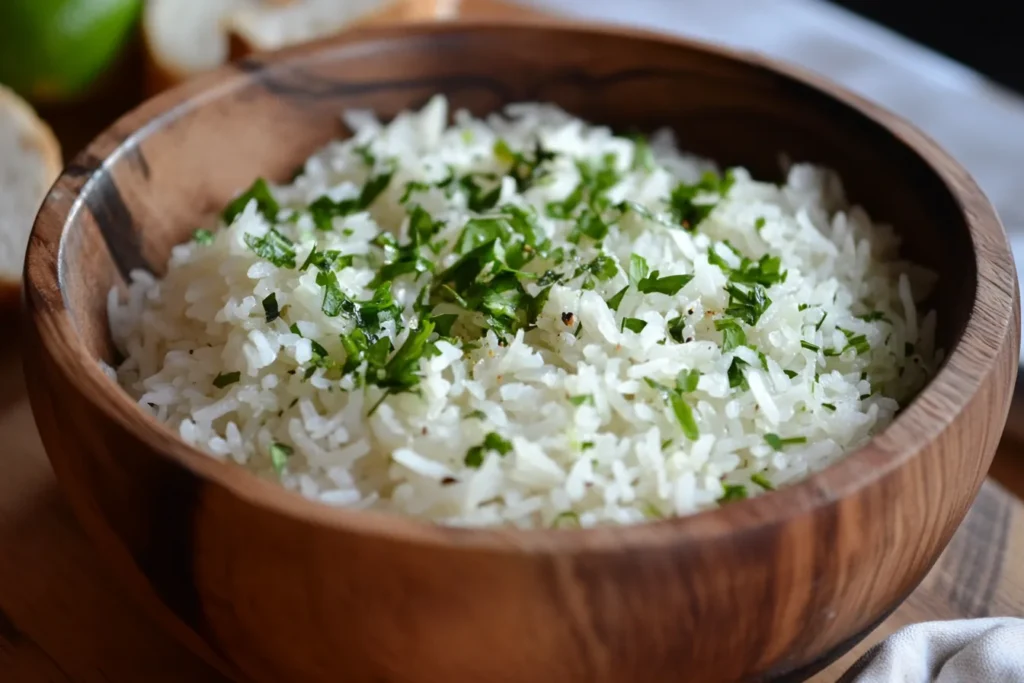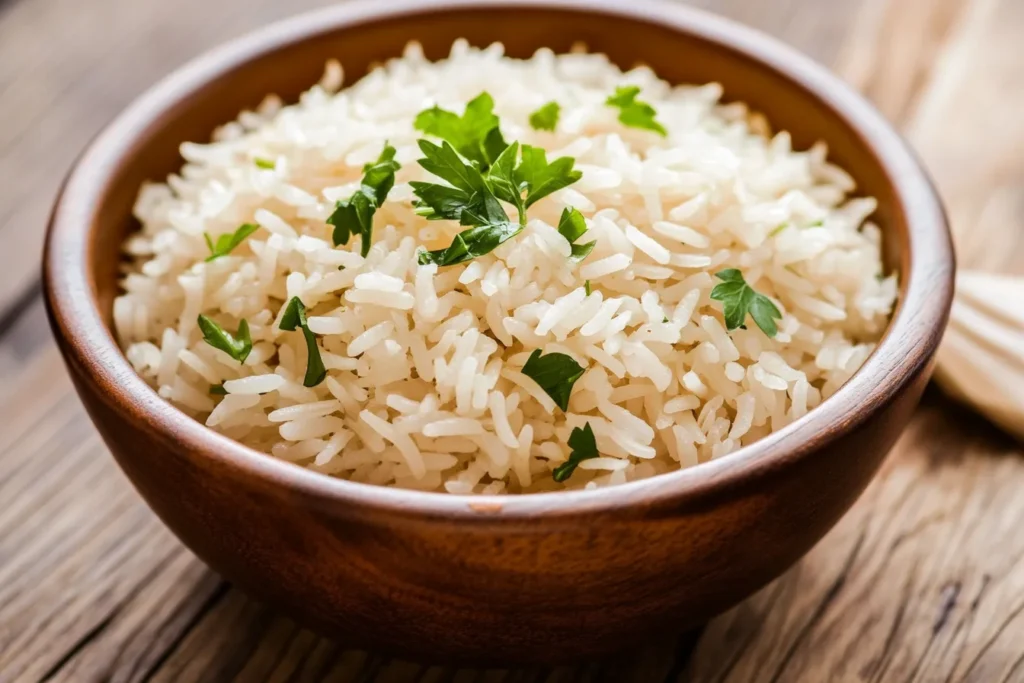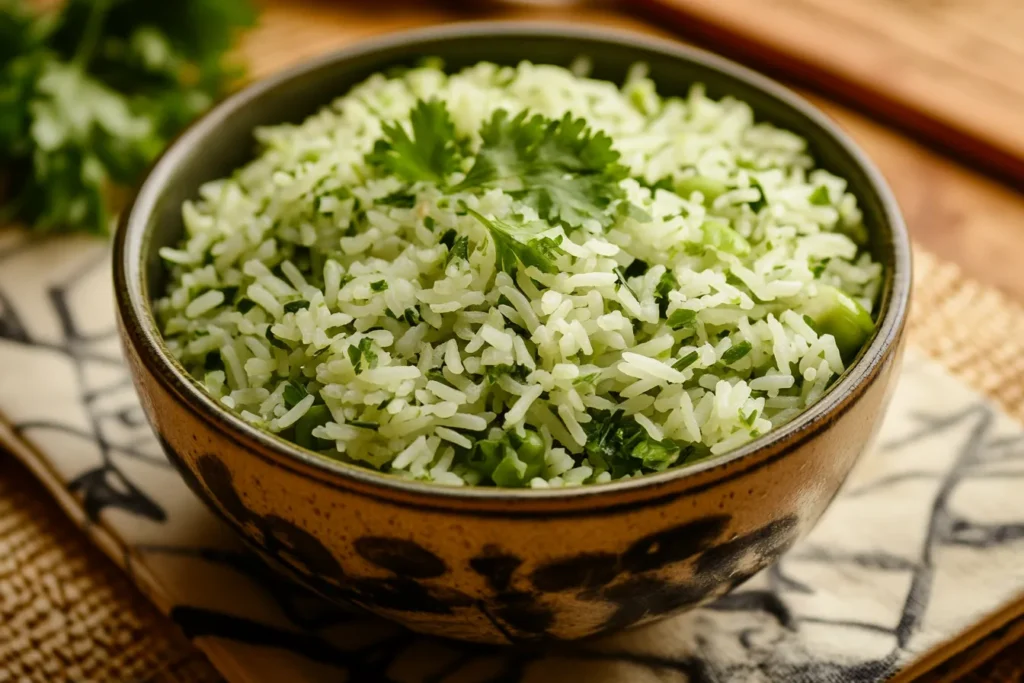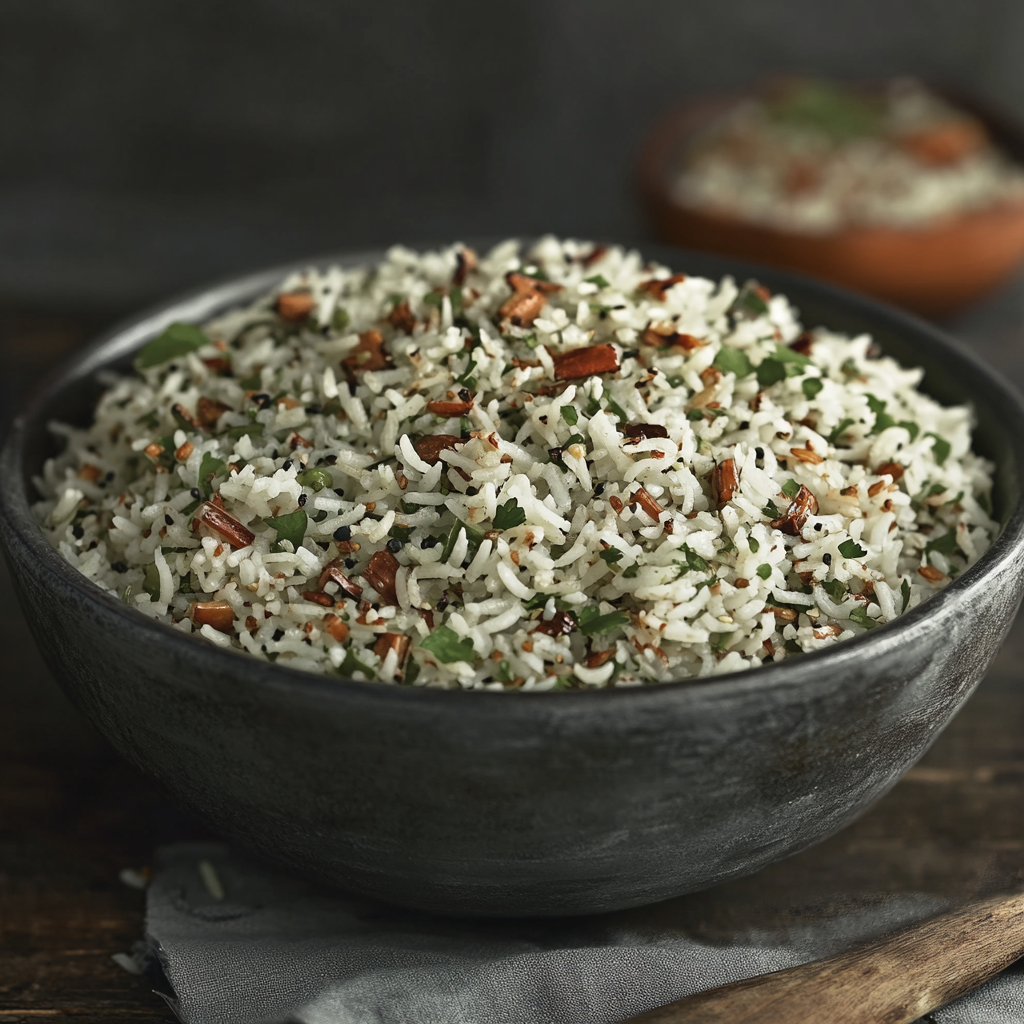Coriander rice, a flavorful dish infused with fresh coriander leaves, is a popular choice in many kitchens worldwide. But is it truly healthy? Let’s explore its nutritional benefits, potential drawbacks, and how it fits into various dietary plans. This article will dive deep into coriander rice’s composition and health implications to help you make informed choices.
1. Introduction to Coriander Rice
Coriander rice, a flavorful dish infused with fresh coriander leaves, is a popular choice in many kitchens worldwide. However, many wonder if it’s truly healthy. To answer this, let’s explore its nutritional benefits, potential drawbacks, and how it fits into various dietary plans.
This dish is a simple yet aromatic combination of cooked rice and coriander leaves. Not only does it bring vibrant flavors to the table, but it also offers several health benefits. Typically, coriander leaves are blended with spices, garlic, and sometimes green chilies to create a fragrant base for the rice.
Overview of the Ingredients:
- Coriander (Cilantro): Fresh leaves are packed with vitamins and a burst of flavor.
- Rice: White or brown rice serves as the primary carbohydrate source.
- Seasonings and Spices: Garlic, ginger, cumin, and green chilies often enhance the dish.
- Optional Add-ins: Peas, carrots, or protein like chicken or tofu for added nutrition.
Because of its versatility, coriander rice is easily customized to suit different dietary preferences and health goals. For instance, adding vegetables or swapping rice for quinoa can enhance its nutritional profile further.

2. Nutritional Profile of Coriander
Coriander, also called cilantro in some parts of the world, isn’t just a flavor enhancer—it’s a powerhouse of nutrients. Additionally, its numerous health-promoting properties make it a valuable addition to any meal.
Key Vitamins and Minerals in Coriander:
- Vitamin K: Essential for blood clotting and bone health, this vitamin is present in abundance.
- Vitamin C: Known for boosting immunity and its antioxidant effects.
- Potassium: Helps regulate blood pressure and fluid balance, contributing to heart health.
Antioxidant Properties of Coriander:
Moreover, coriander contains antioxidants like quercetin and kaempferol, which help combat oxidative stress and inflammation. In the long term, these compounds may lower the risk of chronic diseases, such as heart disease and diabetes. Learn more about coriander’s health benefits.
Given its rich nutrient profile, coriander elevates the health quotient of any dish it’s added to. Whether used as a garnish or a primary ingredient, it provides significant nutritional value.
3. Nutritional Profile of Rice
Rice is a staple food in many cultures and the foundation of coriander rice. However, its nutritional value varies significantly depending on the type of rice used. For instance, brown rice retains its natural layers, offering more fiber, while white rice has been processed for a smoother texture but contains fewer nutrients.
White Rice vs. Brown Rice in Coriander Rice:
- White Rice: Provides quick energy due to its high glycemic index; however, it has lower fiber content.
- Brown Rice: Retains its bran and germ, making it a more nutrient-dense choice that offers higher fiber, vitamins, and minerals.
Caloric and Macronutrient Breakdown:
To compare, a cup of cooked white rice contains approximately:
- Calories: 200
- Carbohydrates: 45g
- Protein: 4g
- Fat: 0.5g
In contrast, a cup of brown rice contains slightly more fiber and protein while delivering similar calorie content.
By choosing brown rice for coriander rice, you can increase the dish’s fiber and nutrient content. Furthermore, it becomes a better choice for those focused on weight management and digestive health.r and nutrient content, making it more suitable for weight management and digestive health.
4. Health Benefits of Coriander Rice
When prepared with nutrient-rich ingredients, coriander rice offers several notable health benefits. Furthermore, the synergy between coriander and rice enhances its overall impact on health.
1. Aiding Digestion:
First, coriander contains natural compounds that promote gut health. For example, its oils can reduce bloating and improve digestion by stimulating digestive enzymes.
2. Boosting Immunity:
In addition to digestive benefits, coriander’s high vitamin C content strengthens the immune system. Coupled with its antioxidant properties, it protects the body against infections and cellular damage.
3. Providing Energy:
Lastly, rice serves as a quick and efficient source of carbohydrates, making coriander rice an excellent choice for energy replenishment—especially after physical activity.
Altogether, coriander rice isn’t just a tasty dish. It’s a wholesome, nutrient-packed option that supports overall wellness when made thoughtfully.
5. Is Coriander Rice Good for Weight Loss?
Coriander rice can be a beneficial addition to a weight-loss diet, provided that it’s prepared mindfully. However, it’s essential to control portion sizes and ingredient choices to maximize its health benefits.
Low-Calorie Versions of Coriander Rice:
For a weight-loss-friendly version:
- Opt for brown rice instead of white rice, as it lowers the dish’s glycemic load.
- Additionally, use minimal oil or ghee to reduce calorie content.
Role of Fiber in Promoting Satiety:
Moreover, fiber from brown rice and added vegetables can help increase satiety. As a result, you’ll feel full longer, reducing the likelihood of overeating during subsequent meals.
To make coriander rice more weight-loss-friendly:
- First, use brown rice or even quinoa as a base.
- Next, incorporate vegetables like zucchini or spinach to boost volume and nutrients.
- Lastly, limit oil or ghee to keep the calorie count in check.
By making these small adjustments, you can enjoy coriander rice as part of a healthy and calorie-controlled diet.
Is Coriander Rice Healthy? (Continued)
6. Coriander Rice for Different Diet Plans
Coriander rice is a versatile dish that can be adapted to suit a variety of dietary preferences and restrictions. Here’s how it fits into different diets:
Vegan and Vegetarian-Friendly Adaptations:
Coriander rice is inherently vegetarian, but it can easily be made vegan by ensuring that no animal-derived ingredients, like ghee, are used. Instead:
- Use vegetable oils like olive or coconut oil.
- Add plant-based protein sources such as chickpeas, tofu, or lentils for a balanced, protein-rich vegan meal.
Gluten-Free and Lactose-Free Options:
Since rice is naturally gluten-free, coriander rice is safe for those with celiac disease or gluten intolerance. For lactose-free preparation:
- Avoid using butter or cream in the dish.
- Substitute with lactose-free margarine or plant-based oils.
Coriander rice’s adaptability makes it a favorite among individuals with dietary restrictions or specific nutritional goals.
7. Potential Drawbacks of Coriander Rice
While coriander rice offers many benefits, some aspects of its preparation can impact its healthiness.
Overuse of Oil or Fats in Preparation:
- Many recipes use generous amounts of oil, ghee, or butter for added flavor, which can significantly increase the dish’s calorie content.
- Using excessive fats can also lead to an imbalance in macronutrients, making the dish unsuitable for certain diets, such as low-fat or calorie-controlled plans.
Impact of High-Carb Rice on Certain Diets:
For those following low-carb diets like keto or managing conditions like diabetes:
- White rice’s high glycemic index can cause rapid spikes in blood sugar levels.
- Substituting with lower-carb alternatives like cauliflower rice or quinoa can make the dish more compatible with these diets.
Addressing these drawbacks involves mindful preparation techniques to ensure that coriander rice remains a healthy and balanced meal option.
8. Customizing Coriander Rice for Better Health
Elevating the nutritional value of coriander rice is easy with a few tweaks.
Using Brown Rice or Quinoa as a Base:
- Brown Rice: Retains more fiber and nutrients, making it a healthier option than white rice.
- Quinoa: A complete protein, quinoa adds both nutrition and a nutty flavor to coriander rice.
Adding Vegetables and Lean Protein for a Balanced Meal:
Incorporating vegetables like:
- Carrots, peas, and bell peppers boost the fiber and vitamin content.
- Adding lean proteins like grilled chicken, shrimp, or tofu makes it a complete, balanced meal.
These customizations ensure that coriander rice caters to a variety of dietary needs and health goals.

9. Coriander Rice for Specific Health Goals
Coriander rice can be tailored for specific health objectives with these approaches:
Recipes for Weight Management:
- Use brown rice or quinoa for added fiber and satiety.
- Cook with minimal oil to reduce calories.
- Add low-calorie vegetables like zucchini or spinach to increase volume.
Recipes for Boosting Gut Health:
Coriander is known for its digestive properties. Pair it with fermented ingredients like yogurt (for non-vegans) or kimchi to promote gut health.
These recipe adaptations can help you align coriander rice with your specific dietary and health goals.
10. Popular Variations of Coriander Rice Healthy Across Cultures
Coriander rice is enjoyed worldwide, with each culture adding its unique spin. Here are some popular versions:
Indian-Style Coriander Rice:
- Features traditional spices like cumin, turmeric, and garam masala.
- Often garnished with fried onions or roasted cashews for added texture and flavor.
Fusion Recipes with Global Influences:
- Mexican-Inspired: Add black beans, corn, and a squeeze of lime for a tangy twist.
- Asian Fusion: Incorporate sesame oil and soy sauce for an umami-rich flavor profile.
These variations demonstrate the dish’s global appeal and adaptability.
Is Coriander Rice Healthy? (Continued)
11. Easy Coriander Rice Recipe for Beginners
Making coriander rice at home is simple and doesn’t require advanced cooking skills. Here’s a beginner-friendly recipe to get started.
Ingredients:
- 1 cup rice (white or brown)
- 1 cup fresh coriander leaves, chopped
- 1 tablespoon oil (olive or coconut oil recommended)
- 1 teaspoon cumin seeds
- 1 green chili, finely chopped (optional, for spice)
- 2 cloves garlic, minced
- 1/2 teaspoon ginger paste
- Salt, to taste
- 2 cups water (or as per rice cooking instructions)
Preparation Steps:
- Prepare the Rice:
- Rinse the rice thoroughly and soak for 15 minutes (optional, for fluffier rice).
- Cook the rice in water with a pinch of salt. Drain and set aside.
- Prepare the Coriander Paste:
- Blend the coriander leaves, garlic, ginger, and green chili into a smooth paste. Add a tablespoon of water if needed.
- Cook the Base:
- Heat oil in a pan and add cumin seeds. Let them splutter.
- Add the prepared coriander paste and sauté until the raw aroma fades.
- Combine and Finish:
- Add the cooked rice to the pan. Mix thoroughly to coat the rice with the coriander paste.
- Season with salt and cook for another 2-3 minutes.
- Serve and Garnish:
- Serve hot, garnished with additional chopped coriander or a wedge of lime.
Nutritional Breakdown (Per Serving, White Rice):
- Calories: 220
- Protein: 4g
- Carbohydrates: 44g
- Fat: 3g
This recipe is quick, healthy, and perfect for meal prepping or a busy weeknight dinner.
12. Tips for Storing and Reheating Coriander Rice
Proper storage and reheating techniques ensure your coriander rice stays fresh and safe to eat.
Storing:
- Refrigeration: Transfer the rice to an airtight container and refrigerate within 2 hours of cooking. It can last up to 3 days.
- Freezing: Portion into freezer-safe containers or bags and freeze for up to 1 month. Thaw overnight in the refrigerator before reheating.
Reheating:
- Microwave: Sprinkle a few drops of water over the rice and microwave for 1-2 minutes to retain moisture.
- Stovetop: Heat in a pan with a teaspoon of water or oil to revive its texture.
Food Safety Considerations:
- Avoid reheating rice more than once, as it increases the risk of bacterial growth.
- Always ensure the rice is heated thoroughly before consumption.
These tips ensure that your coriander rice remains delicious and safe for later meals.
13. Frequently Asked Questions About Coriander Rice
Here are some common questions and answers about coriander rice:
- Is coriander rice good for diabetics?
- Brown rice or quinoa as a base makes it more suitable for diabetics due to their lower glycemic index.
- Can I add protein to coriander rice?
- Yes, add grilled chicken, shrimp, or plant-based options like tofu or chickpeas for a balanced meal.
- Is coriander rice gluten-free?
- Absolutely, as long as gluten-containing additives are avoided.
- Does coriander rice help with digestion?
- Yes, coriander’s natural oils can soothe the stomach and improve digestion.
- What’s the best rice type for weight loss?
- Brown rice is ideal due to its higher fiber and nutrient content.
- Can I use dried coriander instead of fresh?
- Fresh coriander is recommended for its flavor and nutrients, but dried can be used in a pinch.
- How do I make coriander rice spicier?
- Add more green chilies or a dash of red chili powder.
- Is coriander rice suitable for meal prep?
- Yes, it stores well in the refrigerator or freezer for future meals.
- What sides go well with coriander rice?
- Yogurt-based raita, grilled vegetables, or a light curry are great pairings.
- Can I skip the oil to make it fat-free?
- Yes, but sautéing in oil enhances the flavor. Use a non-stick pan to reduce the need for oil.
14. Incorporating Coriander Rice into a Balanced Meal Plan
Coriander rice can be part of a healthy, balanced meal plan when paired with complementary dishes.
Sample Meal Plan:
- Breakfast: Smoothie bowl with fresh fruits and nuts.
- Lunch: Coriander rice with grilled chicken and a side of roasted vegetables.
- Snack: Hummus with carrot and cucumber sticks.
- Dinner: Coriander rice with a lentil soup and steamed greens.
Complementary Dishes to Serve with Coriander Rice:
- Protein Options: Tandoori chicken, paneer tikka, or baked salmon.
- Vegetables: Stir-fried broccoli, sautéed spinach, or a fresh cucumber salad.
- Condiments: A dollop of plain yogurt or a tangy mango chutney.
A thoughtfully planned meal with coriander rice ensures a balance of macronutrients and flavors.

15. The Verdict: Is Coriander Rice Healthy?
Coriander rice is a healthy dish when prepared with wholesome ingredients and balanced proportions. Here’s why:
- Pros:
- Nutrient-rich coriander provides antioxidants, vitamins, and digestive benefits.
- Brown rice or quinoa boosts fiber and nutritional value.
- Customizable to fit various diets and health goals.
- Cons:
- High-calorie fats and white rice may reduce its suitability for weight loss or low-carb diets.
- Requires mindful preparation to avoid unnecessary calories.
Final Thoughts:
Coriander rice can be a flavorful, nutrient-dense addition to your diet when made thoughtfully. By customizing it with healthier ingredients and techniques, you can enjoy this dish as part of a balanced lifestyle.
More FAQs
- Can coriander rice help with inflammation?
- Yes, coriander’s antioxidants may reduce inflammation.
- Is coriander rice suitable for kids?
- Absolutely, especially when made with mild spices.
- How can I make coriander rice more filling?
- Add protein and fiber-rich vegetables to increase satiety.
- What’s a low-carb substitute for rice in coriander rice?
- Cauliflower rice or shirataki rice works well.
- Can coriander rice be eaten cold?
- Yes, it can be enjoyed as a cold rice salad.
- Is coriander rice good for muscle recovery?
- Pairing it with protein like chicken or tofu can make it great post-workout.
- How long does coriander rice stay fresh?
- Up to 3 days in the refrigerator and 1 month in the freezer.
- Can I use frozen coriander for the recipe?
- Fresh is ideal, but frozen coriander can be used if fresh isn’t available.
- Does coriander rice contain allergens?
- It’s naturally allergen-free unless cross-contaminated during preparation.
- What drinks pair well with coriander rice?
- Lassi, herbal tea, or a light citrus drink complement its flavors.
Related Article : Choosing the Best Type of Rice for Coriander Rice

